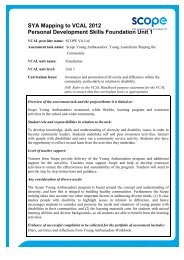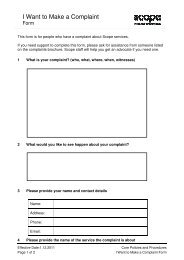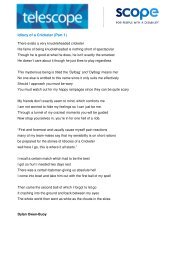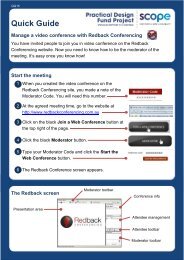Positive behaviour support Getting it right from the start
Positive behaviour support Getting it right from the start
Positive behaviour support Getting it right from the start
Create successful ePaper yourself
Turn your PDF publications into a flip-book with our unique Google optimized e-Paper software.
56 <strong>Pos<strong>it</strong>ive</strong> <strong>behaviour</strong> <strong>support</strong>: <strong>Getting</strong> <strong>it</strong> <strong>right</strong> <strong>from</strong> <strong>the</strong> <strong>start</strong> - Facil<strong>it</strong>ators reference manual<br />
PowerPoint 78*<br />
Functional <strong>behaviour</strong> assessment<br />
‘It is not a matter of what causes self injury or what causes aggression or what causes<br />
stereotyped or repet<strong>it</strong>ive movements but for each of <strong>the</strong>se difficult forms of <strong>behaviour</strong>,<br />
what does <strong>it</strong> do for <strong>the</strong> individual, what purpose does <strong>it</strong> serve for <strong>the</strong>m in life?’<br />
Brown and Brown 1994<br />
A functional <strong>behaviour</strong> assessment aims to identify which particular needs of <strong>the</strong> person are met<br />
through <strong>the</strong>ir <strong>behaviour</strong>. This means trying to work out what message or purpose <strong>the</strong> <strong>behaviour</strong> is<br />
serving for <strong>the</strong> person. Determining why <strong>the</strong> <strong>behaviour</strong> is occurring is an important <strong>start</strong>ing point<br />
in selecting pos<strong>it</strong>ive <strong>behaviour</strong> <strong>support</strong> strategies to be included in a <strong>behaviour</strong> <strong>support</strong> plan.<br />
W<strong>it</strong>hout conducting a functional <strong>behaviour</strong> assessment <strong>it</strong> is very easy to jump to inaccurate<br />
conclusions of why a person is behaving in a certain way. In turn this can result in <strong>the</strong> selection<br />
of inappropriate strategies that will not address <strong>the</strong> person’s needs or have pos<strong>it</strong>ive effects on<br />
<strong>the</strong> <strong>behaviour</strong>.<br />
Inappropriate strategies can often make <strong>the</strong> <strong>behaviour</strong> worse, lead to an increase in <strong>the</strong><br />
frequency, intens<strong>it</strong>y and duration of <strong>the</strong> <strong>behaviour</strong> and give rise to new and even more<br />
problematic <strong>behaviour</strong>s. There is also a risk that <strong>it</strong> can bring about serious harm to <strong>the</strong> person<br />
and o<strong>the</strong>rs involved.<br />
For fur<strong>the</strong>r information refer to <strong>the</strong> Office of <strong>the</strong> Senior Pract<strong>it</strong>ioner webs<strong>it</strong>e<br />
www.dhs.vic.gov.au/ds/osp for <strong>Pos<strong>it</strong>ive</strong> Solutions in Practice; <strong>Getting</strong> It Right <strong>from</strong> <strong>the</strong><br />
Start, <strong>the</strong> value of a good functional <strong>behaviour</strong> assessment.

















